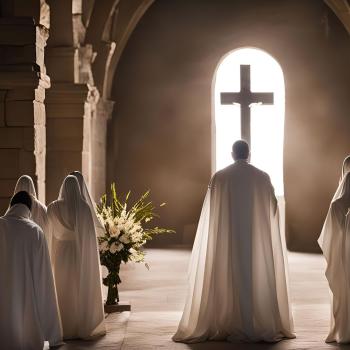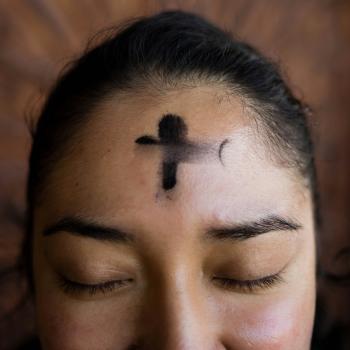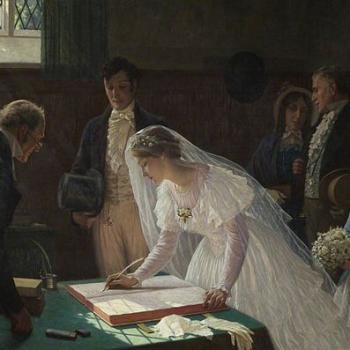For the past two weeks I have been in Europe on business. The first weekend I was there I went to a Sunday night mass at a Jesuit parish in Granada: the Church of the Sacred Heart. It was unremarkable, and I refer you to a previous post where I discussed going to mass in Spain.
On the second weekend I was in Rome, and the choices of where to go to mass were overwhelming. I ended up ruling out St. Peter’s because of the lines. On Saturday I stood in line for two hours to get into the basilica, and there is no separate line for mass attendance. Indeed, I was quite surprised to the extent which the major churches in Rome act simultaneously as liturgical centers and tourist attractions, with mass being said and at the same time tour groups being led through the church. I guess this is inevitable, given the importance of tourism in Rome, but there is also an Italian cultural streak that is quite relaxed about the rules. The signs all say that tourism is not allowed during services, but I have seen guards standing in front of these signs chatting amiably (but quietly) with tourists while mass is being said at the other end of the church. To American sensibilities this seems very disrespectful, but somehow in Italy it works. On the other hand, all the major churches seem to have chapels for the Blessed Sacrament and these are scrupulously maintained as places of quiet prayer.
I did hear some of the music for the Saturday evening mass in St. Peter’s and it was quite lovely. Despite some grumbling about the low quality of the papal choirs under Pope Benedict, I heard nothing to complain about. I did not recognize any of the selections, so I cannot comment on what was chosen.
On Sunday, I decided, more or less at random, to go to mass at St. John Lateran. The website listed masses every hour on the hour, so after breakfast and packing, I set out to walk down. My route took me past the Basilica of St. Mary Major, so I ducked inside. They were in the middle of their high mass for the day. The liturgy was the ordinary form in Latin. Looking at some websites, it seems that Latin masses are fairly common at the larger churches in Rome, though definitely still in the minority—usually one mass out of five or six on Sunday. (I didn’t see anything about EF masses, but I wasn’t looking, either.)
Arriving at St. John Lateran I went in to discover that they were in the middle of the 10 am mass, though by my watch it was pushing 10:45—my first clue that mass times in Rome are somewhat more flexible than the clockwork schedules on their websites. I went into the side chapel to pray before the Blessed Sacrament. This also gave me the opportunity to listen to the music, which was a small choir that had lovely harmonies; all the sections seemed to be Baroque. I am not really a fan of the Baroque, but they provided a very peaceful backdrop while praying. The mass itself was quite well attended, and responses were actually audible from the congregation, even in the closed off chapel where I was praying.
I was therefore looking forward to the next mass: it was schedule for 11 but started around 11:10 or so. I was disappointed in some ways. It was sparsely attended, and was a de minimus production that reminded me of going to church in Spain. There was no music and the congregation mumbled its responses. The lectors were okay—my Italian is very rusty but they were clear enough that I could piece together which reading it was. I was initially thrown by the first reading from Job (Job 7:1-7) as in Italian it kept using the word mercenario, which is usually (and obviously) translated as “mercenary”. It turns out that it has a figurative meaning as “hireling” which is the sense used in Job. As has been my experience in Spain, the homily seemed longer than is typical in the US; my Italian, however, gave up the ghost, as it were, in trying to follow it.
The priest used Eucharistic Prayer II. Receiving communion was the usual chaos I have experienced in both Spain and Italy: rather than going up in the orderly fashion one sees in the US, people just decide, almost at random, when to go up. At times it seems less a line than a rugby scrum (though without any physical contact!). Actually, in my experience, Americans are the most orderly during communion of any Church I have visited. The Germans are also very orderly as well, followed by the French, though somewhat less so.
One thing I did notice was that a large number of people left after receiving communion. Some people still do this in the US, but my sense is that it has gotten less common. Though, on the other hand, since I tend to sit very close to the front, I am not in a good position to judge if people are sneaking out or not. At this mass, though, I noticed from the empty seats that a number of folks had left.
So, in terms of the overall liturgical experience, I chose the “wrong” mass. This was counter-balanced by the awe inspiring nature of St. John Lateran, as can be seen in this picture (not mine—I almost never take pictures while traveling):
And it almost goes without saying that any mass has its riches. Next time I am in Rome I may try to go to mass at a smaller church to see how mass differs there. But this morning, despite the snow and cold—our third or fourth winter storm of the year—I am looking forward to the homely joys of mass in my home parish. As Dorothy said, “there’s no place like home.”
















